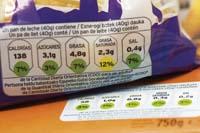Longer food labeling... more consumer knowledge?

To this end, Regulation EC 1924/2006 established the nutritional profiles that must meet food. The profiles would indicate on the label the degree of health of each food. This initiative could correspond to semaphors that lately we see on the surfaces of the packages, but much more complex.
Variables and Inexpressive
The nutritional profiles have not been invented in fact. They have long been used in nutrition sciences to classify foods for different purposes according to their composition. The novelty is the use of the profile as a label.
Politics is the origin of this change. Government policies have highlighted the relationship of certain foods with diseases after past decades in which an effort has been made to introduce fruits, vegetables, and products into the diet. In other words, governments have sharpened measures on certain foods they consider to be negative and want the sale of inappropriate foods to be reduced, indicating their presence on the labels. The negative ingredients are fats, fatty acids, sugars and salts.
But as with many policies, as they move from paper to practice, problems have appeared. These profiles are not really capable of expressing the general health of a food. As soon as we started the idea, we realized why no one had ever happened before: today there is no such system with enough scientific consensus. Although the effect on the health of certain foods is analyzed, in an individualized manner, the need to take into account the integrity of the diet when providing the consumer with the information obtained is indicated. In fact, in addition to food, there are many other important factors in the consumption of food: their quantity and with what they are consumed, as well as sex, age, means of life and the nutritional needs of the person. Therefore, it is not possible to provide a valid information for all consumers.
On the other hand, there are hundreds of methods to define nutritional profiles and there is no consensus classification of food. Finally, they offer a limited vision, since they measure what the food has, but not what is missing. For example, most fruits and vegetables receive a positive evaluation in most systems, but it may be of interest to consumers to know that they usually have few proteins. On the contrary, the presence of a censorable component is sufficient for the food to have a general negative resolution. In the end, although all the traffic lights are green, we would not make sure that we receive all the necessary foods.
It is more difficult to find a joint opinion on processed foods. The results vary according to the categories of methods, regardless of whether the weight or energy contribution is taken as a reference. Therefore, it is not very clear how to give scientific advice to fix profiles on labels.
The examples are given by the European Commission itself. According to the first pilot classification method, common bread was also among inappropriate foods. It was more flexible to try with another method and considered healthy donuts. The system should be ready for 2009 and has not yet been launched.
Risks of simplification
Until the launch of the official system, the supermarket has been filled with traffic lights. They are much easier to read than profiles, but simplification has more risk.
They have already had some negative consequences. Most of the traffic lights have ruled out some foods that have always been important and, through the publication of the information itself, it has been made known that they are not healthy. In this situation are some cereals, vegetable oils and many of the dairy products. Since the nutritional profiles of these foods -- especially olive oil and cheese -- contain reproof elements, red semaphors are often applied (interspersed with some greens). This does not mean that the intake of olive oil is harmful to health, since it is known that vegetable oil, as well as cereals, have many benefits. But regulation and semaphoric systems consider the profile and health information almost equivalent, and many consumers misunderstand the message.
The situation is aggravated with some dairy products like cheese. Rigorous studies have shown that despite its high concentration of fat, cheese is very nutritious. But as 80% of the fat of the cheese is saturated, in most of the nutritional profiles it is valued negatively and is not taken into account that it contains good quality proteins, vitamins and minerals. A piece of cheese of 50 grams provides between 300 and 500 mg of easily assimilable calcium -- many adults do not reach 1,200 mg of calcium we need daily --.
In addition, cured cheeses do not contain lactose and can be a unique source of calcium for adults who cannot digest lactose. They also contain interesting antihypertensive peptides. Finally, 30-40% of saturated fat is constituted by short chain fatty acids. Besides being able to supply energy directly to the organism, these short chain fatty acids do not accumulate in adipose tissue. Can we therefore say that nutritional profiles or semaphors provide direct information about vegetable oils, cereals and cheeses and dairy products? We believe that no. These new policies focused on products such as snacks with high calorie content and low nutritional content, but it is observed that other valuable products are about to be out of our diet.
We cannot consider 400 million Europeans as the only consumer when determining the relationship between food and health. People need different foods and diets depending on their age, sex, physiological state, lifestyle, etc. And in all these diets, dairy products, vegetable oils, cereals, fruits, vegetables, etc. They can be adequate in their proper measure. Nutritional profiles (including traffic lights) can be guideline, but it is essential to know how to place foods in the diet.
Buletina
Bidali zure helbide elektronikoa eta jaso asteroko buletina zure sarrera-ontzian











